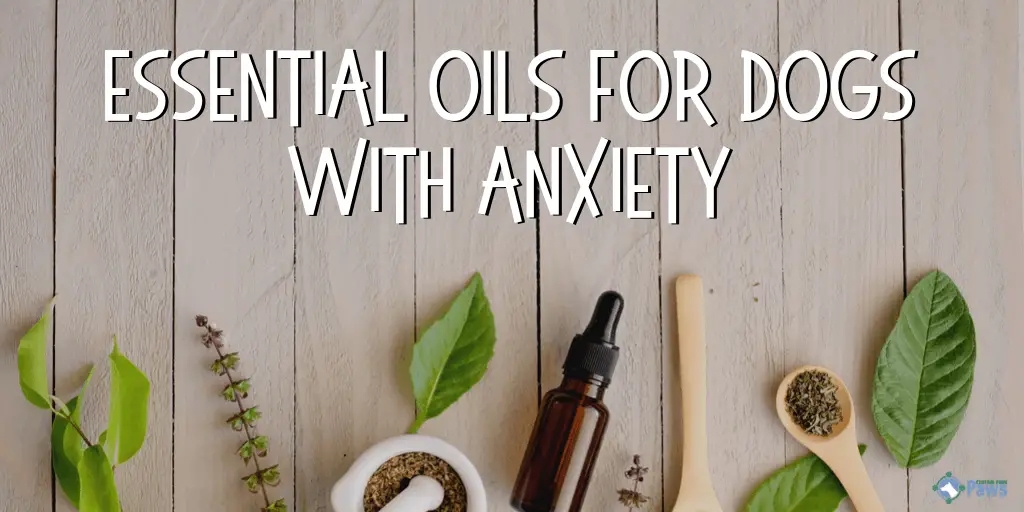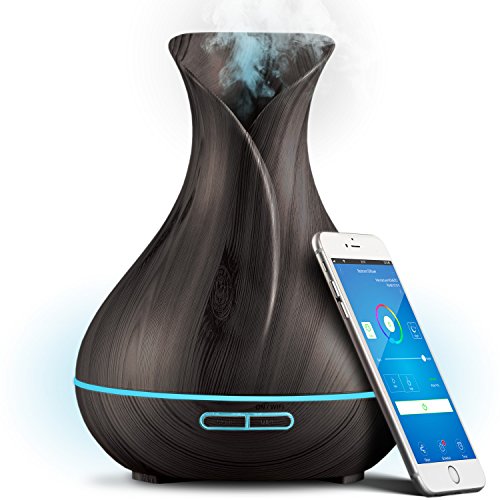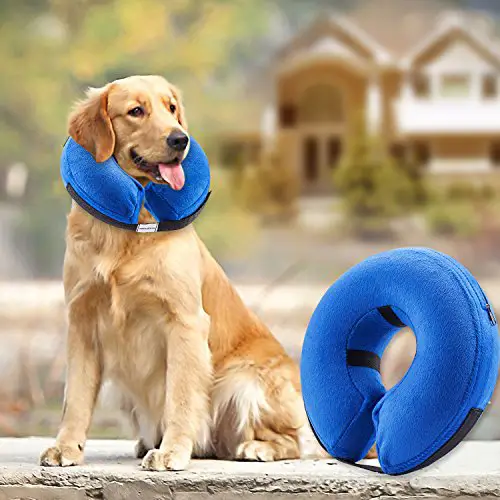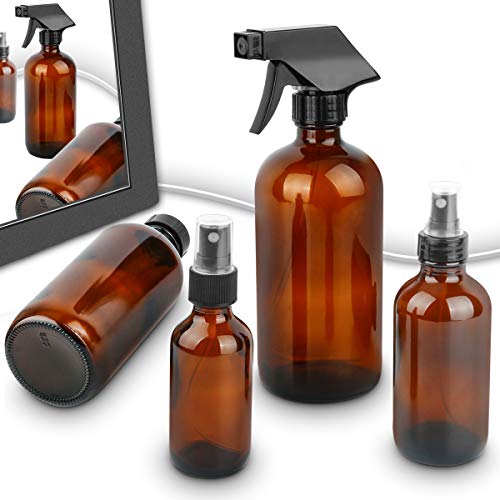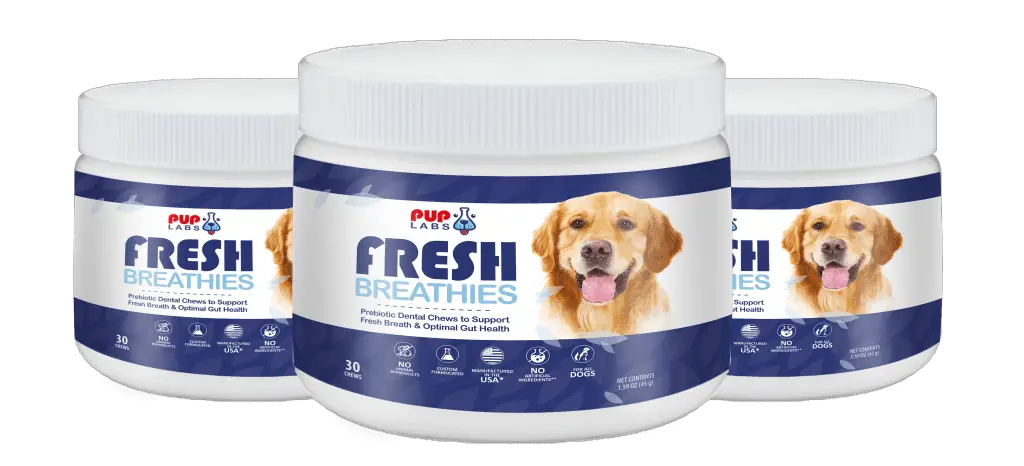My first experience with anxiety in dogs was with Sophie.
She was only about ten years old when it started to manifest.
I brought her into the vet and they confirmed there was nothing physically wrong, but also said it wasn’t uncommon for older dogs to start showing nighttime anxiety.
Though nighttime anxiety in senior dogs is not uncommon, there’s no substantiated reason for why it happens and, unfortunately, no real cure.
Since then, we do our best to manage Sophie’s anxiety, and quite, unfortunately, her anxiety has not been contained to just the evenings.
Sophie’s anxiety now starts from the moment she wakes up until she goes to bed. She shakes and pants when it’s not managed correctly.
Her anxiety is worsened by a lack of exercise or when she has to go to the vet.
However, we are now able to manage her stress with medication, exercise, and holistic methods.
Dog Anxiety
Dogs show anxiety in a variety of behaviors from panting, pacing, destructive behavior, drooling, urinating or defecating, and in some cases even aggression[1].
When Sophie’s anxiety first started, I tried several over the counter supplements and holistic methods to help her relax.
In the beginning supplements, essential oils, and exercise were enough to keep her comfortable.
Though, as time went on, we did have to add prescription medicine to manage her anxiety better.
What we ultimately found works best is a combination of supportive care methods.
What are Essential Oils?

Essential oils are extracted from the various parts of plants, including the seeds, fruit, wood/bark, flowers, leaves, or roots[2].
Essential oils have been derived from the plants either through distilling or mechanically using a cold-press method.
They’re called “essential” oils because they’re from the plant’s essence.
How do Essential Oils Work?
The two most common and safest methods of using essential oils are aromatherapy and topical application.
Aromatherapy
Dogs have between 125-500+ million olfactory cells, which directly link to the brain[3]; and to put this into perspective, humans only have between 5-10 million olfactory cells.
The olfactory cells send information to be interpreted by the brain, which in turn causes a reaction in the central nervous system[4].
What this means is there is a physical and mental response to different smells.
Topical Application

When applied topically, the skin absorbs the oils directly into the body.
The oils must be diluted before application.
Dog’s skin is more sensitive and absorbs the oils faster than humans, so it is vital to use the proper dosage.
Are All Essential Oils Safe for Dogs?
There is a common misconception that natural equals safer or better.
However, many natural things in our world are far from safe, especially when it comes to our dogs.

As with all things, some oils are safe, some are poisonous, and some that are somewhere in between.
A lot of how we use these oils will also dictate their level of safety. For example, some of the oils we use for aromatherapy may be unsafe to use topically or orally.
Also, it is essential to check with your veterinarian to ensure that the oils won’t interact with your dog’s medications.
Below I have listed several safe essential oils that may help your dog relax.
However, keep in mind that dogs have different sensitivities, so even though these are frequently safe options, some dogs may still have an adverse reaction.
How to Use Essential Oils Safely with Your Dog
I mentioned the two conventional methods of using essential oils earlier: directly applied to the skin and through inhaling in the essence of the oils.
However, there is a third method, and that is oral.
Oral use of essential oils should only be used when directly prescribed by a veterinarian familiar with holistic medicine.
When employing essential oils topically, you should always dilute the essential oils with a carrier oil. There are a variety of safe carrier oils including coconut, sunflower, jojoba, Aloe Vera, and apricot kernel.
Dogs who have respiratory issues should not be exposed to aromatherapy.
Also, caution should be exercised with dogs who have flattened noses, such as Pugs or English Bulldogs.
Additionally, essential oils should not be used with puppies under the age of 10 weeks old.
Topical Application Safety
When using essential oils with the topical method, it is important to follow a few key rules:
Always use a carrier oil to dilute the essential oil
- It is important you apply the oil to an area your dog can’t reach, or use an Elizabethan collar (aka cone of shame) to ensure your pup can’t lick it off
- Start with small doses; a dog’s skin is more sensitive and more absorbent than a human’s
- Keep an eye on them for at least 24 hours after application as adverse effects can be seen in as short of a time as 30 minutes or as long as 24 hours
Aromatherapy Safety
When using essential oils through aromatherapy, keep the following in mind:
- Your dog’s sense of smell is far more sensitive than yours, so cut the dose down when using essential oils aromatically
- If you share your home with felines as well as dogs, check the oils you’ve chosen are safe to be used around cats as they are even more sensitive to smells
- Be certain your dog can get away from the scent if it bothers them; in other words, don’t spray the bed in their crate and leave them in there for the day
- Use essential oils in a well-ventilated area so that if there is an adverse reaction, it can be eliminated from the area quickly
- You must use the correct size diffuser for the room so that the smell doesn’t overpower the area
- Do not use aromatherapy near your dog’s eating area
- Test the essential oils in a larger area before applying it to areas around your dog’s sleeping space
Adverse Reactions
Watch for these adverse reactions when using essential oils with your dog:
- Sneezing, coughing, or wheezing
- Vomiting
- Loss of balance or weakness
- Loss of appetite
- Pawing or rubbing their face
- Lethargy
- Labored, shallow, or increased breathing
- Intensified anxiety or restlessness
- Skin irritation – redness or swelling
- Itching, scratching, or rubbing the area where it was applied
Why Use Essential Oils for Dogs with Anxiety?
Essential oils have been used for hundreds of years to remedy a wide variety of physical and mental ailments in humans and, more recently, in animals.
The majority of the time, when used properly essential oils, can be both safe and effective and rarely have adverse drug interactions.
Essential oils used to relieve anxiety and encourage relaxation can be highly effective through aromatherapy[5].
The direct link between the olfactory cells and the dog’s nervous system is what makes aromatherapy an excellent method for essential oils.
What to Look for When Choosing Essential Oils
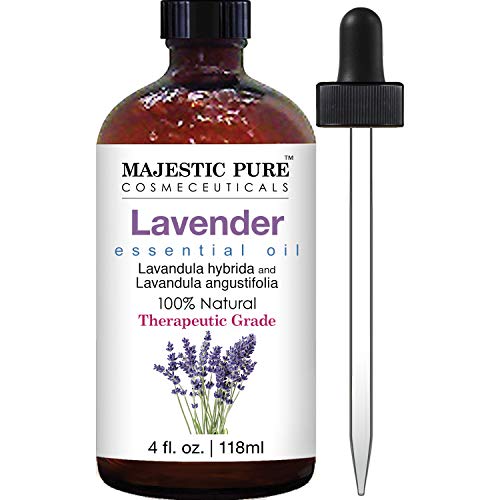
There is an abundance of essential oil brands to choose from, and every price point imaginable.
Essential oils fall into the category of “you get what you pay for.”
Because essential oils are expensive to produce, buying less expensive products will likely result in a diluted or synthetic product[6].
This does not mean that the most costly oils will be best, but expect to pay varying amounts depending on the oil.
Because some oils are more expensive than others to create, it is not unexpected to find a half-ounce bottle of oil for over $30 and others to be as low as $6.
Essential Oil Buying Tips
Other things to know before you buy:
- Essential oils should be stored appropriately in dark glass bottles to keep them from spoiling or being contaminated
- Look for oils that list the plant’s Latin name in addition to the common name; there are variations of oils from the same plant family. For instance, there are a variety of lavender plants used for essential oils, and some are more potent than others!
- A little goes a long way; remember, essential oils are concentrated. Large bottles of oils aren’t always best as essential oils do have a shelf life
- Avoid synthetic or overly diluted oils as they are not as effective as natural oils
The Best Essential Oils to Help Dogs with Anxiety
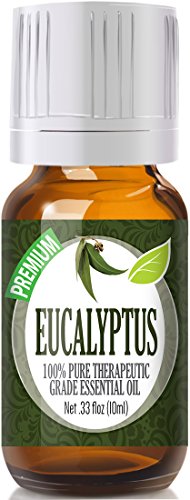
Now for the part we have all been waiting for: the list of calming essential oils.
This list only contains oils safe for dogs, so though there may be other oils that are good for relaxation, I have only included the dog safe ones.
All of the below essential oils can be used as aromatherapy and some can be used topically.
Remember to check with your veterinarian before using these topically. Be sure they are safe to use on your dog.
In the list below you will find:
- The Latin name
- Information about each oil
- Other benefits of each of the oils
- Product recommendations
| Essential Oil | Latin Name | Aromatherapy? | Topical? | |
|---|---|---|---|---|
| Lavender | Lavandula angustifolia | Yes | Yes | Buy Now |
| Chamomile | Matricaria chamomilla or Chamamelum nobile | Yes | Yes | Buy Now |
| Frankincense | Boswellia carterii | Yes | Yes | Buy Now |
| Myrrh | Commiphora myrrha | Yes | Caution | Buy Now |
| Marjoram | Origanum marjorana | Yes | Yes | Buy Now |
| Valerian | Valeriana officinalis | Yes | Yes | Buy Now |
| Basil | Ocimum basilicu | Yes | No | Buy Now |
| Cinnamon | Cinnamomum zeylanicum | Yes | Caution | Buy Now |
| Jasmine | Jasminum grandiflorum | Yes | Yes | Buy Now |
Lavender
Latin Name: Lavandula angustifolia
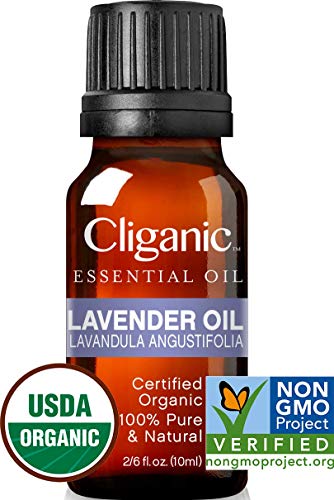
Lavender is an herb available in a multitude of variations, and not all varieties are safe or effective for use with your dog.
One of the best options of lavenders to use is English lavender (Lavandula angustifolia).
According to Dr. Randy Kidd, DVM, Lavendula stoechas, (aka French lavender or Spanish lavender), is often found in essential oils but is a toxic variety and should be avoided when using on or around your pets.
There is also an option called lavandin, which is a combination of lavenders, and though it is not toxic, it is not as effective as pure lavender.
Lavender is one of the most popular herbs used for relaxation and is found in a variety of products like shampoo, sprays, and calming chews.
Other Benefits
- Fights depression
- Relieves panic
- Helps with focus and clarity
Product Recommendation
Chamomile
Latin Name: Matricaria chamomilla or Chamamelum nobile
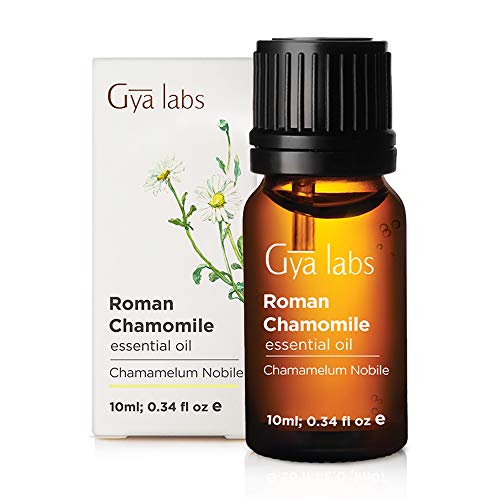
Chamomile is a daisy-like flower that is often found in products containing lavender.
The two oils complement each other in promoting feelings of calm and relaxation.
In addition to its oil form, chamomile is commonly found in teas.
German or Roman chamomile is the recommended variety for use in essential oils for your dog.
Other Benefits
- Helps with upset stomachs
- Reduces hyperactivity
- Decreases depression
- Promotes restful sleep
- Relieves skin irritation
- Promotes good skin and coat
- Promotes good joint health
Product Recommendations
Frankincense
Latin Name: Boswellia carterii
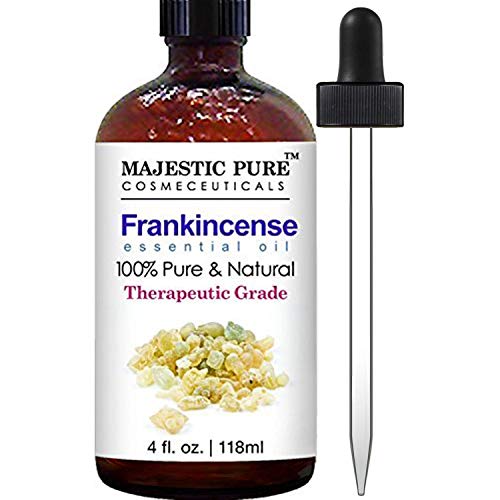
Frankincense is the dried sap, resin, from trees found in Oman, Yemen, and the Horn of Africa[7].
It has a spicy, earthy fragrance.
It should be noted that if you are pregnant, this is not a good oil to be used in your home.
Other Benefits
- Boosts immune system
- Reduces external skin ulcers
- Increases blood flow
Product Recommendation
Myrrh
Latin Name: Commiphora myrrha
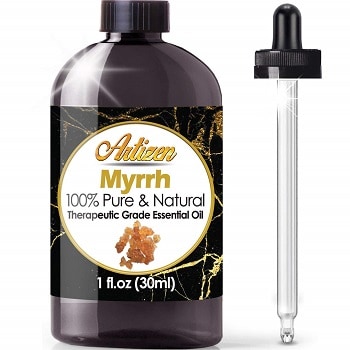
Myrrh is like Frankincense in that it, too, is a resin originating from trees.
It is amber in color and has an earthy aroma.
Myrrh is not safe for ingestion so use care so your pup can’t lick or ingest this oil.
Other Benefits
- Anti-inflammatory
- Anti-viral
- Boosts immune system
- Repels ticks
Product Recommendation
Marjoram
Latin Name: Origanum marjorana
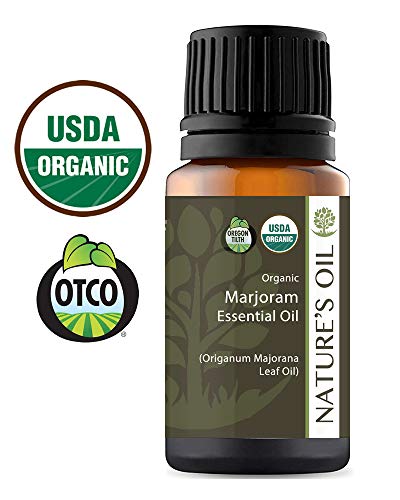
Marjoram is a common herb found in kitchens and perennial gardens.
It has a light spicy smell and blends well with basil, lavender, and cinnamon.
Other Benefits
- Decreases inflammation
- Encourages good GI health
- Anti-bacterial and Anti-fungal
- Reduces joint pain
Product Recommendation
Valerian
Latin Name: Valeriana officinalis
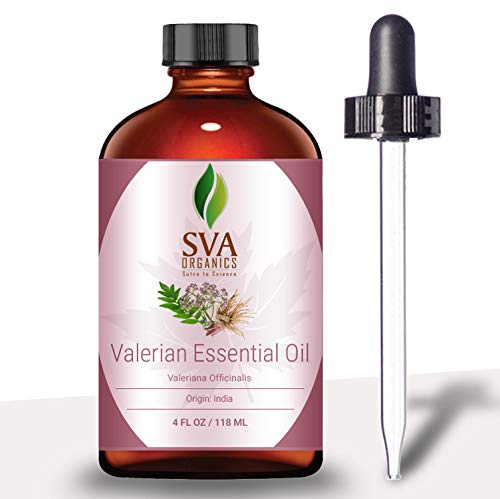
Valerian is a flowering perennial originating from Europe and Asia.
It is commonly used for its calming effect.
Valerian is useful to combine with lavender and chamomile.
Because of its potent sedative nature, it is best to use it with caution.
Also, use sparingly if applying directly to the skin, as it can cause skin irritation.
Other Benefits
- Fights depression
- Encourages a restful night’s sleep
- Helps emotional balance
Product Recommendation
Basil
Latin Name: Ocimum basilicu
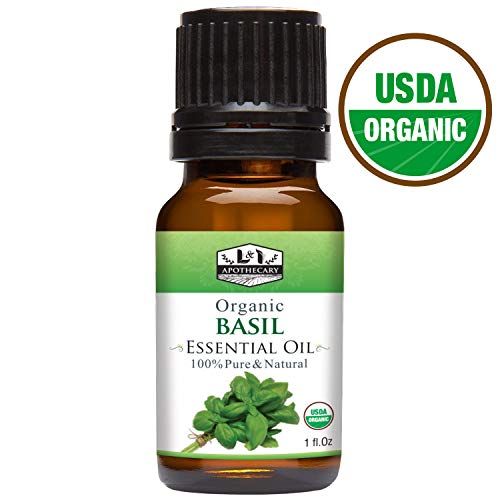
Basil is one of my preferred herbs to use in the kitchen.
But in addition to its deliciousness, this herb is also used for its healing properties.
Though this is a safe herb to eat, basil is not recommended for oral or topical use, so it is best used for aromatherapy only.
Other Benefits
- Antibacterial
- Antiseptic
- Antiviral
- Promotes mental alertness
- Encourages good GI health
Product Recommendation
Cinnamon
Latin Name: Cinnamomum zeylanicum
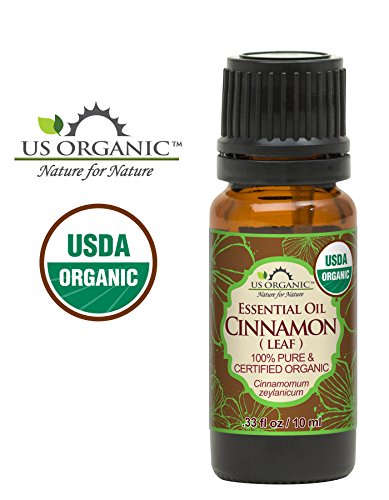
Cinnamon not only has a warm spicy aroma, but it also has several health benefits.
Though it is a safe spice for humans, it can cause GI upset in dogs.
It is best to use this oil with caution, ensuring your dog can’t ingest it through licking.
Combining cinnamon with other oils can not only create a pleasant aroma, but it can also enhance its healing properties.
Note: When choosing a cinnamon oil, be sure the oil is derived from the leaves and not the bark. The oil from the bark can cause severe skin irritation and lacks potency in aromatherapy.
Cinnamon is a very potent oil and shouldn’t be used if anyone in the home has liver or kidney disease, is pregnant, or if there are children under the age of 6[8].
Other Benefits
- Antibacterial
- Decreases depression
Product Recommendation
Jasmine
Latin Name: Jasminum grandiflorum
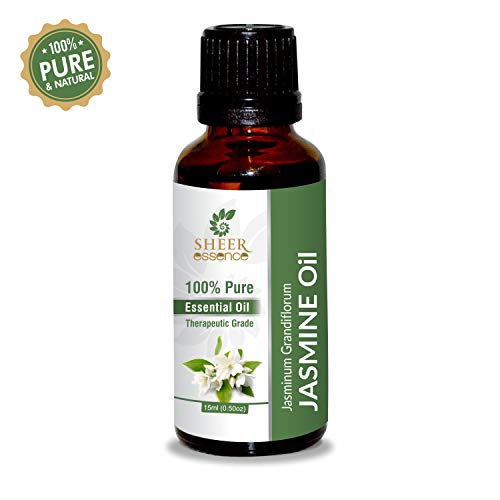
Jasmine isn’t just a princess in Aladdin; it is also a very beneficial flower.
It has a strong floral smell that will brighten any home.
It works well with myrrh and Roman chamomile.
Other Benefits
- Antibacterial
- Decreases signs of depression
- Increases energy
- Helps to alleviate joint and muscle pain
Product Recommendation
Essential oil options and combinations are abundant.
These are some of the safer and more traditionally used for relaxation and anxiety relief.
Essential Oil Therapy Accessories
Instead of including it with the individual oils listed below, here are some general product recommendations for items used in conjunction with essential oils.
Diffusers
Carrier Oils
Spray Bottles
- Esarora Glass Spray Bottles – I like these because they come in a variety of sizes, so I keep a smaller one in my car and one in my RV for when we camp.
Reading
And finally, my favorite book on the subject:
Alternative Options to Help Relieve Anxiety
As I mentioned earlier, I use a combination of anxiety relievers.
Some work better than others, but all dogs are unique.
From my personal experience with having dogs with anxiety, it is a trial and error process.
Acupuncture
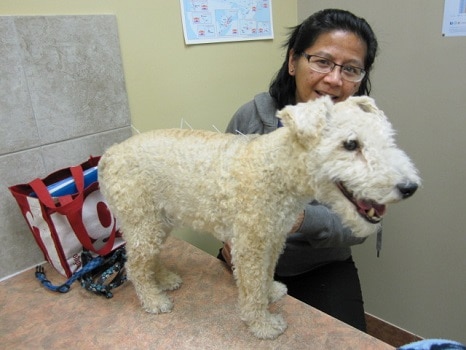
Photo by Dr. Mark Rubensohn (CC BY 2.0)
Not all veterinary offices offer this service, but if your vet office doesn’t, I am sure they would refer you to a vet that does.
This method worked well for Daisy but not for Sophie.
Pricing varies on where you have it done, but overall it wasn’t as expensive as I thought it would be.
Trazadone
This is a conventional anti-anxiety medication used for dogs and humans.
Dogs seem to tolerate much better than humans.
Trazadone works excellent for Sophie but made Daisy’s anxiety worse as she aged.
You’ll need to get a prescription to try Trazadone but once you do, you can purchase it online.
Thundershirt
This can work well for situational anxiety.
I use it when Sophie’s anxiety is going to worsen due to the situation, such as a vet appointment or storm.
The Thundershirt worked well before we started the Trazadone, but since then we haven’t needed it.
CBD
This didn’t help Sophie, but it did help Daisy.
I will say that I didn’t try CBD for very long so that may be part of its ineffectiveness.
Other people have had great success giving their dogs CBD oil, though.
The reason I didn’t pursue it more aggressively with Sophie is that she didn’t like the taste, so it was a pain trying to get her to take it.
Calming Chews
A lot of the essential oils discussed above can be found as common ingredients in calming chews.
The ingredients in these chews are usually in their original form and not just the concentrated oil.
Adaptil Calm
This is a synthetic pheromone that resembles the pheromones released by a dog’s mother.
I’ve tried this and it didn’t seem to work near as well as diffused essential oils.
The great thing about Adaptil Calm is that it is scentless to humans.
Conclusion
As a dog parent who has watched their dogs suffer from anxiety, I know how difficult it can be.
Fortunately, there are various ways we can help provide supportive care to help keep them calm.
Whether you are looking for a calming agent as a preventative measure or a chronic issue, essential oils are an excellent choice.
Unfortunately, anxiety in dogs can become quite severe and may require veterinary intervention. However, even if you are using other methods to manage your dog’s issues, using essential oils can still help reduce symptoms.
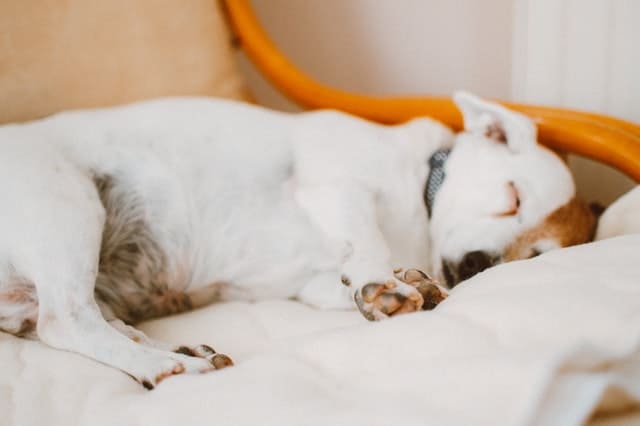
I think that anxiety in dogs is one of the more challenging issues I have ever faced as a dog parent.
If you have a dog with anxiety issues, know you are not alone. The majority of the time, your dog’s anxiety can be managed.
Finding the right solution for your dog’s anxiety takes both patience and tenacity, but I promise it is all worth it in the end.
Resources
- https://www.akc.org/expert-advice/health/treating-dog-anxiety/
- https://www.ncbi.nlm.nih.gov/pmc/articles/PMC5456241/
- http://veterinarycalendar.dvm360.com/aromatherapy-proceedings
- https://www.webmd.com/skin-problems-and-treatments/news/20170809/essential-oils-natural-doesnt-mean-risk-free
- https://www.medicalnewstoday.com/articles/324478.php
- https://www.verywellhealth.com/tips-on-buying-essential-oils-88796
- https://www.livescience.com/25670-what-is-frankincense.html
- Essential Oils, Natural Remedies (2015) Berkley, CA: Althea Press

